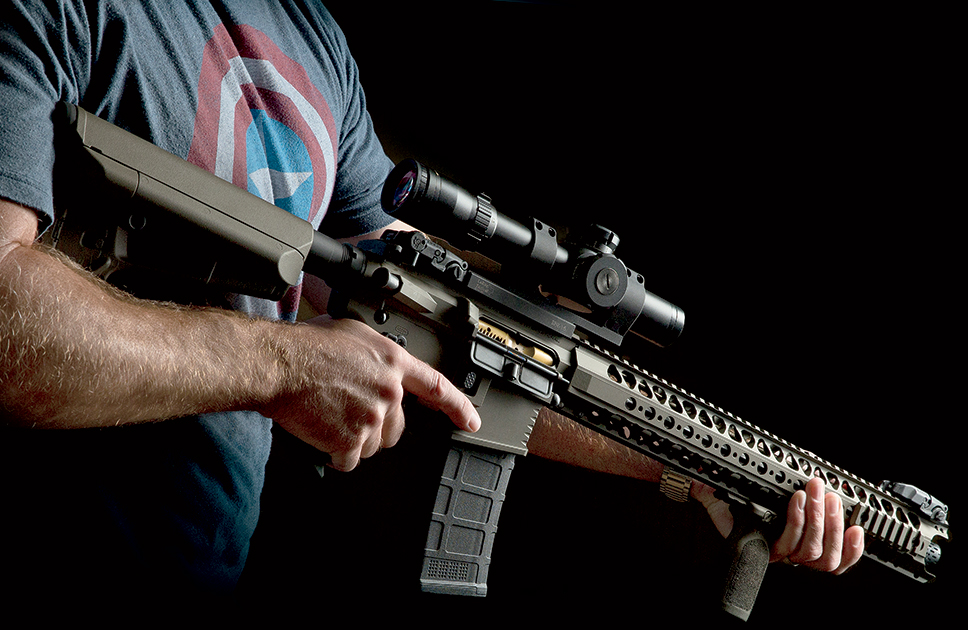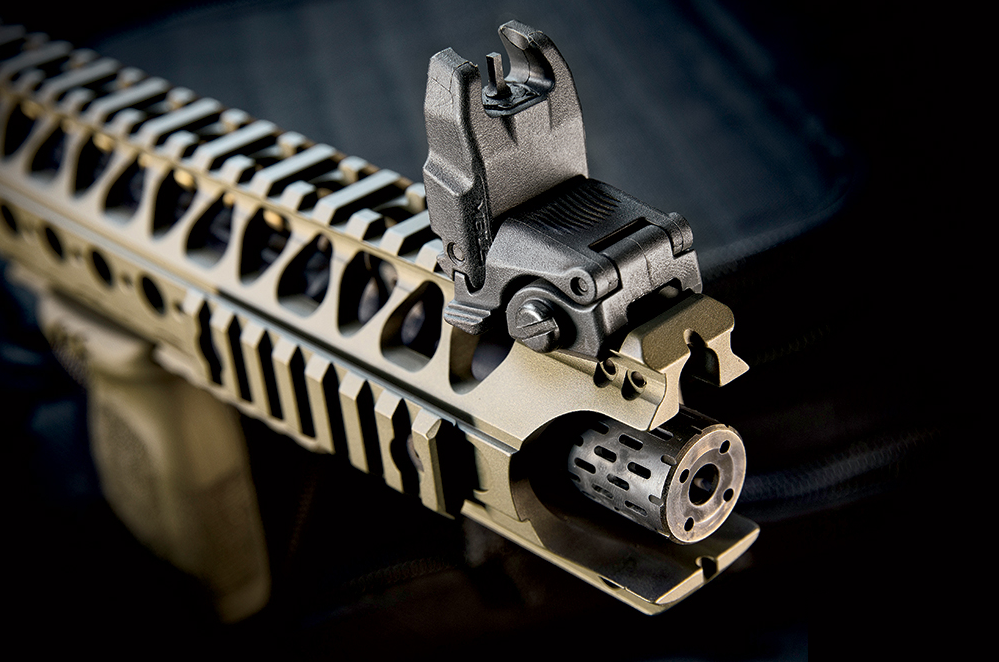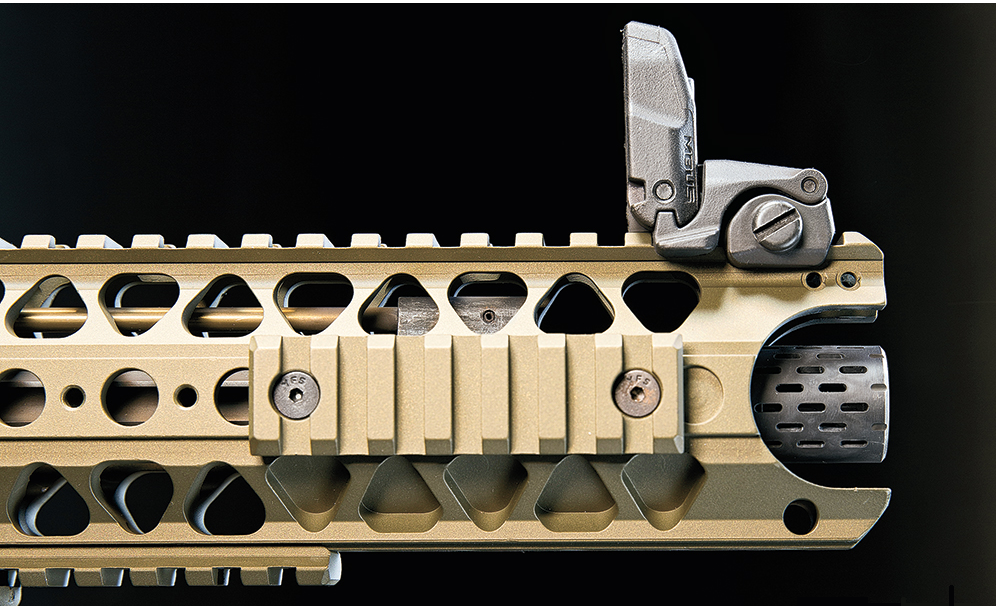Salient Arms International Tier 1 AR-15 Review
24th Jul 2014

A large part of the AR industry is building rifles from parts made by three primary manufacturers. Most of the time it’d be hard to tell who built an AR without looking at the rollmark on the lower receiver. This level of commonality isn’t a bad thing. Assembly of those parts, even if they are common across competing brands, is an art all by itself, and so is the customer service that should support any product sold. So while it’s hard to visually distinguish one AR from another, not all ARs are created equal.
Salient Arms does not fall into that category. The Tier 1 rifle I tested is easily the most unique and custom AR I’ve ever handled. I’ve never seen an AR where so many surfaces and components have been touched or massaged to improve the classic Stoner design. The only stock parts I found on the rifle were the forward assist, receiver extension assembly and takedown pins. They appear identical to those components found on other ARs in my possession. Everything else has been manufactured, stippled, machined, coated and/or treated by Salient Arms.
The goal of Salient with its Tier 1 model is to build the ultimate combat AR that offers the owner the utmost reliability, shootability and flexibility with his rifle. They are so passionate about attaining this goal that they invested considerable time and effort in creating the rifle they sent me to test — serial number 000001. In the short time I had the rifle, I found that Salient is a manufacturer of the highest quality and that their products do perform as good as they look.
THE BIG BITS
Salient machines its own upper receivers, lower receivers and forends out of billet aluminum. Both the upper and lower are beautifully machined and covered in a Salient Arms proprietary brown Cerakote. The lower has an integral triggerguard that is bowed to accommodate a gloved finger and a flared magazine well to help expedite magazine changes. The lower receiver also comes standard with a Seekins Precision magazine release and bolt catch. While the magazine release is machined from billet aluminum and mostly cosmetic, the bolt catch is machined from tool steel and much less likely to break should someone decide to repeatedly dry-fire the lower without an upper attached. In my opinion, the Seekins bolt catch is the best one on the market today.
The Tier 1 model also comes with a Battle Arms Developments Ambidextrous Selector Switch, aka “BAD ASS,” a component that is also the best in its class. My rifle came set up the way I prefer, with the standard-length lever on the left of the receiver and the short lever on the right. The two are interchangeable, and there are other levers available, so the shooter can set up his rifle however he prefers.
The upper is also machined from billet and is the perfect counterpart to the lower. Both upper and lower are formed in the same angular style and fit together very well. The upper comes with a standard forward assist. Of note, the brass deflector is smaller and at a shallower angle to prevent damaging the brass on extraction.
The forend is manufactured by Salient and machined from solid billet. It is 16 inches long and extends past the barrel to the end of the compensator. Some argue that long forends are for game guns and not for duty-bound tactical rifles. Nonsense.
Long forends are essential on tactical rifles because they allow the shooter more positional flexibility when using cover. Long forends that protect the barrel can be laid over cover or on their side, and the barrel will always be free floating, guaranteeing no shift in point of impact. The longer forend also lets us move our support hand closer to or away from the muzzle, ensuring that we can get either very close to our cover or use it as a support while firing.
Salient Arms has taken the free-floating forend one step further in not only using it to protect the barrel, but also using the end of the forend as a shroud for the compensator. This novel approach means that the flash generated from a compensator can be contained and kept from giving away the shooter’s firing position. It also requires that the shooter understand that if he gets too aggressive with his support-hand placement, he can get his hand in front of the muzzle. This would require simian-like arms and intellect, but I guess it’s still possible.
The forend is beautifully executed and threaded to accept Picatinny-rail sections at the 3, 6 and 9 o’clock positions. Just to show how much Salient Arms is in the known and is willing to add the extra detail, the Pic-rail sections are countersunk to ride lower on the rail when attached. This time-intensive detail removes fractions of an inch in the forend’s girth but makes the rifle more comfortable to hold in the hand. It is one of many little things found on the rifle that showcase Salient’s precision machining ability and forward thinking.

THE LITTLE BITS
This Salient Tier 1 example has a standard Mil-Spec bolt-carrier group, complete with Carpenter 158 bolt. The company is looking into other materials for the bolt and might go to 9310 or AerMet in the future, but they haven’t finished testing either of those materials yet. In the meantime, Carpenter 158 will keep those who worship at the Mil-Spec altar happy.
They kept the standard bolt-carrier group (BCG) because lightening the mass of this component would make it more sensitive to fouling. Once mass gets moving, it wants to stay moving. Lightening the BCG makes it less able to plow through carbon and debris that collects in the receiver during those high-round-count sessions.
The entire bolt carrier and gas key are coated in titanium nitride (TiN), giving them that golden color. TiN has awesome abrasion resistance, disperses heat well and has some natural lubricity properties. It is an excellent choice for bolt-carrier treatments. Unlike nickel boron (NiB), TiN goes on in a much thinner coat, so parts won’t bind.
The most unique aspect of this Salient AR is the rifle-length gas system on a 14½-inch barrel, leaving about 1½ inches of dwell time. When I first saw the arrangement, I was skeptical that it would work.
Normally, an AR needs at least 3½ inches of dwell time to function correctly, dwell time being the time it takes the bullet to travel between the gas port and the muzzle, measured in inches. The gas system opens when the bullet passes under the gas port and pressurizes until the bullet exits the muzzle. This gulp of gas is what cycles the bolt-carrier group.
There’s a big difference between 1½ inches and 3½ inches, so I asked Adrian Chavez, co-owner of Salient Arms, how they split the atom with their gas system. “We made a large chamber under a small gas port with another chamber on top. That creates a venturi. The venturi effect forces the gas coming through the port to speed up but also lowers the pressure.”
With the gas coming through the port double-timing it back to the carrier key, the system doesn’t require the usual dwell time to operate reliably. The secondary effect of dropping the pressure on the backside of the gas port is that it reduces the speed at which the bolt carrier unlocks and extracts the spent case. Slower unlocking speeds equate to longer bolt life and slower extractor wear — good things for a rifle designed for combat use. Of course, lower pressures also make the gun more comfortable to shoot because they generate less recoil, not that the recoil of the 5.56 is anything to fear.
The barrel riding below the Salient gas system is from Shilen. The barrel is stainless steel, button rifled and has a 1:8 twist rate. The 1:8 rate worked well on the wide variety of ammunition I fired through it. Salient contoured the barrel pretty aggressively, and the contour design is proprietary. The barrel also has flutes to help keep down weight. Salient orders the barrels from Shilen with their proprietary contour, then chambers and flutes them on-site. Using traditional terms, the Salient barrel fits well into the “lightweight” category.
The entire rifle is coated in Cerakote, the shade also being proprietary but done by Joint Force Enterprises. Before selecting the colors for their rifles, Salient conducted extensive research on how the human eye works and how we recognize rifles as rifles. The studies they reviewed indicated that the two colors most associated with and recognized as rifles are black and silver. The two colors least recognizable as firearms are the shade of brown that you see here and a gray color that will also be available soon. While they have their reasons for choosing the colors they did, I like the brown because it looks incredible and is different from the FDE or various browns and tans we’re starting to see on a lot of ARs. Aesthetics shouldn’t be our main reason for action, but in this case Salient found a way to make what researchers said worked look good, too.
AT THE RANGE
I took three different loads with me to the test range and checked all of them for accuracy. All groups were five shots at 100 yards. I also used an Oehler 35P chronograph to measure velocities, standard deviation and extreme spread.
The first load I fired was the Black Hills 52-grain match hollowpoint. This load almost always shoots well out of any AR in which it’s tested. The average velocity for the 52-grain load was 2,934 with an extreme spread of 52 feet per second (fps) and a standard deviation of 19 fps. This was also the most accurate load I tested, with an average group of .79 inch and a best group of .61.
The 52-grain load was also the only load that didn’t function with total reliability. I fired approximately 35 rounds of this ammunition through the rifle, and I had the bolt-carrier group twice fail to lock back on an empty magazine and once fail to pick up a round and feed it into the chamber. The rifle had problems with this ammo because the bullet was moving at 2,900-plus fps — too fast for the rifle to get a big-enough gulp of gas to function. These problems vanished when we moved to heavier projectiles.
The next load I tested was the Black Hills 69-grain Sierra MatchKing. It worked flawlessly in the rifle, averaging 1.08 inches for groups with a best group of .92 inch. Muzzle velocities averaged 2,676 fps, with an extreme spread of 72 and a standard deviation of 32.
The last load was the Hornady 75-grain boattail hollowpoint that had a muzzle velocity of 2,538, an extreme spread of 108 and a standard deviation of 43. The best group measured 1.13 inches, and the average group size was 1.28.
I attribute the increasing group sizes to heat. Once I started shooting, I paused only long enough to load magazines and put up new targets. The barrel in the Salient rifle is very high quality, but it is still a light barrel, and light barrels feel the effects of heat before the heavier ones do. The difficulty lays in finding the delicate balance between weight and accuracy during sustained fire. Salient and their proprietary contour have done a great job of creating a barrel that is light, accurate and, even when it gets hot, will still outshoot a lot of the competition.
Perhaps most shocking about the rifle’s performance is that it had more than 10,000 rounds down the pipe before I received it for testing. Even with the high round count, the rifle performed exceptionally well and is a sub-MOA shooter if you allow it to cool between groups.
For those interested in purchasing the Salient Tier 1, it’s best to order early. MSRP for the first 600 rifles will be $2,995. After that, the price jumps to $3,295. While the rifle isn’t for everyone, it is a great fit for those interested in highly customized, purpose-built tactical rifles.

